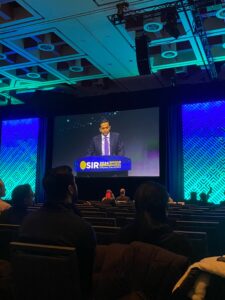This year’s Society of Interventional Radiology (SIR) annual scientific meeting (23–28 March, Salt Lake City, USA) gave recognition to select abstracts during the closing plenary session. Introduced by SIR 2024 programme chair Bulent Arslan (Rush University, Chicago, USA), who commended the “strong” and “compelling” presentations, speakers offered data which challenge preconceptions about disease states and treatment strategies.

Abin Sajan (Columbia Irving Medical Center, New York, USA), presenting first, relayed the team’s evaluation of the long-term efficacy of haemorrhoid artery embolization (HAE) in patients with symptomatic haemorrhoids.
Providing initial background, Sajan noted that haemorrhoid disease affects between 5–10% of the general population and is the third most common outpatient gastrointestinal diagnosis. Current treatment options, he outlined, range from least to most invasive, including lifestyle modifications, office-based procedures such as rubber-band ligation, and lastly surgical haemorrhoidectomy. Sajan explained however that office-based procedures currently have recurrence rates as high as 40–50%.
With intent to confirm the effectiveness of HAE, Sajan then described his team’s retrospective, single-centre study of 221 patients—“the largest sample size to date”, the speaker noted. All patients had symptomatic internal haemorrhoids and were observed over the course of two years between August 2021 and April 2023. Their cohort, comprised of 115 males and 106 females, had an average age of 57.1 years and an average haemorrhoid grade (HG) of 2.1. Patient symptoms ranged from less than five years to more than 20 years, which truly “shows the disease burden of this population”, Sajan said.
After undergoing embolization of the abnormal vascular blush at the haemorrhoidal cushion, patients were evaluated at baseline, 1–, 3–, and 6–12 months for haemorrhoid-related pain (HRP), haemorrhoidal symptoms score (HSS), quality of life (QoL), French bleeding score (FBS), and HG.
Here, Sajan detailed their results, stating that for “every single outcome measure was significant across every single timepoint”. Technical success was achieved in 100% of cases and a 90% clinical success was also reported, with 21 patients requiring repeat embolization. 19 out of the 21 patients had a middle-rectal artery supply which was embolized.
“Haemorrhoidal artery embolization is an effective and durable treatment option for haemorrhagic disease with a very low risk profile,” he summarised. “Next steps will include a comparison to standard treatments such as rubber-band ligation.” Finally, Sajan asserted that the current evidence is sufficient to place HAE within the treatment algorithm for symptomatic haemorrhoid treatment.
Novel ex vivo human liver for microwave ablation research

Following Sajan, Carlos B Ortiz (University of Texas Health Centre at San Antonio, San Antonio, USA) discussed the novel creation of dual-perfused ex-vivo human liver models for the investigation of microwave ablation (MWA).
In collaboration with local transplant surgeons and the Texas Organ Sharing Alliance (TOSA), Ortiz and his team gained research consent and received human research livers from deceased organ donors using standard surgical and transplant preservation techniques. He described that a fluoroscopic compatible ex vivo dual arterial and portal perfusion system was used to perfuse and oxygenate the organ. MWA was performed using a 2.45GHz system (Angiodynamics) at 140 Watts for six minutes followed by placement of a spinal needle to mark the trajectory of the probe. MWA zones were segmented along the MWA trajectory to obtain maximal short axis diameter (SAD) and long axis diameter (LAD) measurements. Ellipsoid volume and sphericity were then calculated.
Receiving a total of 12 livers, seven underwent “successful” perfusion and MWA procedures, with an average cold ischaemic time of 76.8 hours. Continuous bile production was observed in five perfused livers, including the two cirrhotic livers, while average oxygen consumption was 11.4 + 8.3mL/ min. No bile production was noted in livers with >60 hours cold ischaemic time. Comparing perfused and non-perfused MWA, Ortiz expanded that perfused resulted in significantly smaller MWA dimensions than nonperfused ablations, with a difference of approximately 28%. Additionally, in a sub-analysis, the speaker described a “statistically significant increase” in perfused MWA zones in livers with steatosis compared to those with cirrhosis.
“We report the successful creation of a dual-perfused human liver model,” Ortiz continued, “this model can produce the heat-sink effect and enable the study of different tissue types.”
Breast cancer recurrence after cryoablation

Jolie Jean (Weill Cornell Department of Radiology, New York, USA) was next to present, addressing breast cancer recurrence after cryoablation. Giving brief context, Jean outlined that the National Comprehensive Cancer Network (NCCN) in the USA set guidelines in which surgery is the “cornerstone for locoregional control” of breast cancer. “Presenting a unique challenge,” she said, “are women who are poor surgical candidates or who refuse surgery.”
Breast cryoablation has been studied in recent clinical trials which have demonstrated its effectiveness in low-risk cancers less than 1.5cm, Jean said. Due to a “paucity” in literature, Jean’s team set out to evaluate breast cancer recurrence after cryoablation in a broader range of cancer subtypes a and sizes, who were poor surgical candidates or refused surgery.
Their single institution retrospective study included 60 patients with an average age of 75. Of these patients, 48 had invasive ductal carcinoma (IDC), five with invasive lobular carcinoma, and seven who had other histology. Tumour size ranged from (0.3-9cm), with average size of 2.5cm±1.8cm. Jean stated that a multi-probe approach was taken for tumours greater than 1.4cm with a series of freeze-thaw cycles to achieve a 1cm margin.
“All procedures were well tolerated,” Jean described for attendees, noting that “minimal or no” sedation was used based on patient preference. Following the procedure, patients were imaged using mammography and ultrasound, which at a median follow-up of 16 months, showed a recurrence rate of 10% (six patients).
Patients with poorly differentiated disease had higher risk of recurrence, while invasive lobular carcinoma status, oestrogen/progesterone receptor status and triple-negative breast cancer (TNBC) status did not contribute to the risk. Jean added that tumour size did not differ between recurrence and nonrecurrence groups.
“To date, this is the largest single-institution retrospective experience describing recurrence rates after cryoablation of primary breast cancer. Our study demonstrates that cryoablation can be performed effectively in patients with large tumours using a multi-probe approach,” Jean summarised, adding that they hope this research and prior studies will “pave the way” for US Food and Drug Administration approval and insurance reimbursement.
Radiofrequency ablation for intrahepatic cholangiocarcinoma

Qian Yu (University of Chicago, Chicago, USA) was next to the podium, describing a 20-year analysis of radiofrequency ablation for intrahepatic cholangiocarcinoma (iCCA). In this “rare but very aggressive” indication, Yu began, the majority of tumours are not resectable at the time of diagnosis, and following resection, recurrence can be high.
Data on this topic are “sparse”, thereby, through using the Surveillance, Epidemiology, and End Results (SEER) database from 2000–2020, the researchers extracted data from approximately 27% of the US population diagnosed with cancer, evaluating trends in survival among iCCA patients undergoing thermal ablation. For a total of 192 patients, the median overall survival (OS) in these data was 28 months, with one, three, and five-year OS of 79.3%, 35.8%, and 19.8%, respectively. Looking closely at the data, Yu noted that patient survival increased after 2010, and that “as expected”, tumour burden correlated with survival.
“The survival curve of local disease appears better than extrahepatic disease,” Yu said, with tumours of less than 3cm demonstrating better survival than larger tumours. For patients with tumours of less than 3cm, survival was reported as an “impressive” 49 months, Yu detailed. “This tells us that ablation can be effective in carefully selected patients.” Yet, there is still a need for high-level evidence, Yu stated, drawing attention to the size of their cohort despite the 20-year time range. “It is beyond a single-centre’s ability to gather a homogenous, yet large enough sample size—future institutional collaboration is key for this research to move forward,” Yu finalised.










